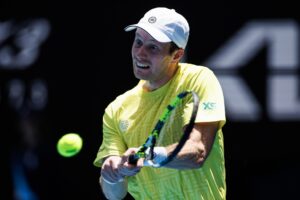Consensus has long been reached that the 16th game of the fifth set was the pivot that changed the course of the 2019 men’s singles final at Wimbledon. Roger Federer’s inability to convert either of the two match points he had at 40-15 in that game has led to speculations of whether the 20-time Grand Slam champion will push past this loss and win another Major.
However, with Federer’s fans posting selfies with him during his break from the Tour in his native Switzerland, it seems as though the 37-year-old has moved on. Yet, the world at large has not ventured beyond the four-hour-57-minute final, coming up with various rationales to contextualize it.
So, then, keeping with the theme here is one more for the count. The similarities between the 2009 and 2019 Wimbledon finals. Of course, that is, beyond the obviousness of Federer featuring in both.
2009 Wimbledon final
Aside from his participation in both match-ups, a decade apart, the transformation in Federer was impossible to miss. In 2009, Federer started on a cautious note ,as though troubled by the vestiges of the rain-fettered final of the year before. Or, perhaps, it was just Andy Roddick’s aggressiveness that hit out at him. Either way, the then-26-year-old was soon down a set and was facing points to trail two-sets-to-love.
Roddick not converting any of the four set points in that second set turned that match. Even though the American looked like he would edge past Federer right up to the 30th game of the fifth set. As is known, that game was the only time in that final Federer broke his rival’s serve, to emerge as a 15-time Slam champion and the fourth man to complete the Channel Slam (winning the French Open and Wimbledon in the same year).
2019 final
Ten years onwards, it was Federer who came out the aggressor in this final against Djokovic, vexing the man who is ruthless in his defensive tactics. He broke down Djokovic’s pattern, did not give him any leeway on his serve, and at all times forced the Serbian to hope for the best – aka, the tiebreaker – while preparing for the worst, a loss.
To draw a bizarre correlation, what Djokovic did on the Second Sunday in 2019 was akin to what Federer had done on the Second Sunday in 2009. Bide his time, and wait for his opponent’s vulnerabilities to show up. In Roddick’s case, it was his mental block against Federer – an on-court foe whom he had struggled to beat, even twice before at the All England Club. For Federer, it was about stumbling in tie-breaks against Djokovic, despite having the strategic wherewithal to win them under usual circumstances.
And where the man who was looking to regain his lost place as the World nN. 1 in 2009 used his acumen to the fullest in outlasting his opponent, in 2019, Federer could not replicate this. He did outrun Djokovic, but he failed to outlast him in what had become a battle of wits as the match drew to a close.
This, then, heightens the lapse in capturing one of those two match points. It is an example of What-goes-around-comes-around. That he has come to be at the receiving end of such results where once he used to hand them out to his hapless rivals. In a way, this can also be perceived as a marker identifying another chapter in Federer’s longevity.
Nonetheless, it is not the first time that this has occurred, nor will it be the last. Regardless of the takeaway for Federer from this loss, a bigger question remains. What would happen if a similar story were to transpire with Djokovic? And that remains an even more intriguing thought to mull about.
Main Photo from Getty






